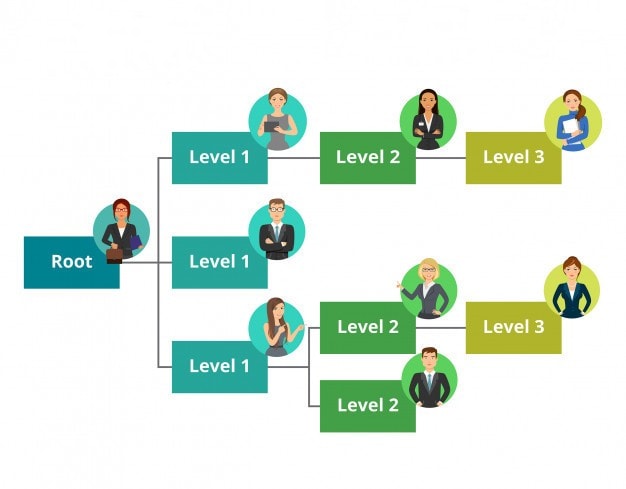
What is Flat Organizational Structures? Meaning, Characteristics, Advantages, and Maintenance

Flat organizational structure is a style of management that emphasizes a decentralized approach to decision-making In this type of organization, there are fewer levels of hierarchy, and employees are given more autonomy to make decisions and take ownership of their work This structure is often associated with increased efficiency, agility, and employee satisfaction
Definition of flat organizational structure
A flat organizational structure involves direct communication between top management, front-line salespeople, floor-level employees, and customers. This type of entity is decentralized, eliminating the need for mid-management levels. The goal of a flat organizational structure is to minimize the hierarchy so that all employees are capable of handling any tasks that come their way.
Meaning of flat organizational structure
In a flat organizational structure, the manager carries a significant amount of responsibility as they directly supervise a larger number of employees. These employees at lower levels rely on the manager for support, guidance, and direction. The purpose of this structure is to empower employees to make independent decisions and minimize bureaucracy. Flat structures are particularly beneficial for small and start-up organizations.
Characteristics of flat organizational structure
The features of a flat organizational structure are
Focus on the customers
Strong emphasis on teams and teamwork
Flexibility between units and jobs
Broadly defined jobs
Few levels of management
A decentralized management approach
Advantages of flat organization structure
.
Improved communication – With fewer layers of management, communication channels become shorter and more direct. This can help to increase transparency and encourage open communication between employees and management. In a flat structure, employees feel more empowered and are more likely to contribute ideas and suggestions.
Increased flexibility – Flat organizations are more agile and adaptable to change. Decision-making is faster and there is a greater ability to respond quickly to market changes or customer needs.
Greater employee satisfaction – Flat organizations provide opportunities for employees to take on more responsibility and have a greater sense of ownership over their work. This can lead to higher job satisfaction and a greater sense of loyalty to the company.
Overall, a flat organizational structure can lead to a more efficient, productive, and engaged workforce, as well as cost savings for the company.
A highly-skilled workforce thrives on the opportunity to showcase their creativity, a possibility that is often curtailed in a vertical hierarchy. However, in a flat organizational structure, this is not only encouraged but also celebrated, leading to a sense of achievement and job satisfaction. This, in turn, enhances employee morale and retention, as employees are more likely to remain with a company that values and nurtures their talents and skills. Additionally, with no mid-level management, frontline staff are trusted to take on greater responsibility and are expected to be experts in their fields, leading to reduced turnover and a more motivated workforce.
Rewritten fragment 10: The flat organizational structure enables faster decision-making as there are fewer individuals involved in the decision-making process. Managers in a flat structure often have the autonomy to make independent decisions, which leads to a more efficient decision-making process. Moreover, employees are empowered to make decisions, reducing the need for micromanagement and decreasing the level of dominance and supervision required.
In a flat organizational structure, high productivity is fostered by a strong sense of ownership and responsibility among employees. This promotes efficiency and output within the company. Additionally, the absence of mid-level management ensures clear and direct communication between top-level executives and lower-level employees. This eliminates the possibility of distorted information and promotes a precise and accurate flow of information.
.
Improved decision-making – Flat organizational structure allows for quicker decision-making as there are fewer levels of hierarchy. This enables employees to make decisions based on their expertise and experience, leading to more effective outcomes.
Greater flexibility – Flat organizational structure facilitates greater flexibility in terms of work assignments and job roles. This allows employees to take on more responsibilities and develop new skills, resulting in a more dynamic and adaptable workforce.
Enhanced employee satisfaction – Flat organizational structure fosters a sense of ownership and responsibility among employees, leading to higher levels of job satisfaction. Employees feel more empowered and valued, resulting in a more engaged and motivated workforce.
Increased innovation – Flat organizational structure promotes a culture of innovation as ideas can be shared more freely and implemented more quickly. This results in a more creative and forward-thinking organization that is better able to adapt to changing market conditions.
Reduced costs – Flat organizational structure can lead to reduced costs as there are fewer layers of management and less bureaucracy. This can result in a more efficient and cost-effective organization that is better able to compete in the marketplace.
Disadvantages of flat organizational structure
The problems of a flat organizational structure are
.
Rewritten:
The risk of losing control is significant in a flat organizational structure, particularly in large corporations where it is impractical to eliminate mid-level management staff. This model poses challenges when dealing with numerous employees, as it can be challenging to maintain control of the situation.
Managing a team can be a challenging task, with a manager often responsible for a large number of employees. This can lead to difficulties in providing daily supervision and maintaining strong connections with team members. The work responsibilities can also limit the time available for building relationships, which can result in strained work relationships over time.
Fragment 15: The flat organizational structure can pose challenges for growth and lead to power struggles among employees. New opportunities may not align with the structure, impeding progress and causing disruption. Additionally, the absence of a direct boss can create confusion and competition for authority.
Employees often feel less motivated in flat organizational structures due to the limited opportunities for career growth and advancement. With few positions available at the top, the climb to success becomes a difficult one. In addition, the lack of upward mobility can lead to low job satisfaction and decreased employee retention rates. Many employees seek out companies that offer clear paths for promotion and reward hard work with career advancement, making it important for organizations to consider ways to keep their employees engaged and motivated.
Fragment 17: Employees can experience confusion about their role and accountability in a flat organizational structure, as they are often required to undertake multiple responsibilities simultaneously. This can lead to difficulties in mental clarity and productivity within the company. Additionally, there is a high level of dependency on the first-line workforce in this structure, and if they lack the necessary expertise, there is a greater risk of errors and issues that can result in financial losses for the company.
Fragment 18 rewritten:
A downside of flat organizational structures is the potential for wasted time as efforts are made to prevent idea duplication among team members. Additionally, the lack of strong supervision and micromanagement can lead to complacency and reduced productivity among workers who may not be motivated to give their best efforts.
How to ensure your flat organizational structure stays healthy
Ensure Transparency for a Healthy Organizational Structure
Transparency is crucial in maintaining a healthy flat organizational structure. Lack of clarity can lead to abuse of power, but transparency makes information accessible and ensures that everyone knows where to go for necessary information. When everyone is aware of everything, rules and regulations hold deeper meaning and contribute to a better functioning organization.
.
At the onset, it is crucial for the management level or leader to establish the tone as it sets the standard for the rest of the organization. The leader should lead by example through their actions, attitude, and work ethics, as this will inspire others to follow suit. Prioritizing professionalism is also key to ensuring the success of a flat organization. It is essential to hire individuals who possess not only the necessary technical skills but also exhibit soft skills, such as empathy and good communication, especially when interacting with customers. This balance of skills will contribute to a healthy and thriving flat organization.
Prioritize your human resources and make sure that your team members feel comfortable asking for assistance and receiving exceptional support. If necessary, offer skills training to empower your employees and maximize their potential. Neglecting your people operations can have a negative impact on the overall health of your flat organizational structure, so invest in your team and foster a positive work environment.















